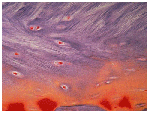
Life on Mars
Your intervertebral discs are quite simply out of this world.
Your intervertebral discs are the things sandwiched between each bony vertebra segment to create your spine. Their job is to ensure your spine is flexible (if they weren’t there your spine would be an unmoving, solid rod of bone), limit movement (you don’t want your spine to bend too much) and to stop your brain from bouncing around in your skull when you walk (by acting as a shock absorber). Each disc can do this because it is composed of an outer fibrocartilage ring (the annulus fibrosus) and a jelly like core (nucleus pulposus).
The purple sky ‘trails’ are highly organized Type I collagen fibers that form the annulus
fibrosus component. They’re the ‘fibro’ part of the outer fibrocartilage ring. Organized collagen is great at resisting the tensile forces applied to each disc when you bend and twist your spine.
The red ‘comets’ are chondrocytes – mature cartilage cells. They contribute to the ‘cartilage’ component of the outer fibrocartilage ring.
The orange-red material at the lower aspect of the image is the jelly-like core
of the disc (the nucleus pulposus). This region is rich in the proteoglycan aggrecan. Aggrecan is a hydrophilic molecule – it draws
water towards it. This is an essential feature of this region because water is difficult to compress. This means that any of the shock-waves that travel along your spine when you walk, run or jump are absorbed and not transferred up your spine to your head where they would cause your brain to rattle around inside your skull causing brain damage.
Imagine if you put too much tensile force on the fibrocartilage ring and it tears. This would cause the hydrophilic jelly center to leak out right? Another name for this is a herniated disc!
Who would have thought histology could be so a-mars-ing,
Histology is from the microscope of Moran and Rowley and Mars is a drawing from the telescope of NASA



